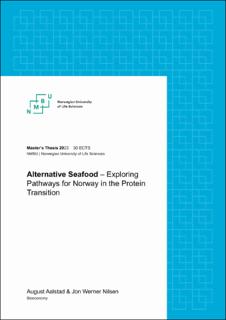| dc.description.abstract | Our global food system is facing major challenges. The growing global population and demand for animal proteins are driving resource pressures, environmental impacts, and hazardous health effects for humans and animals. If we are to feed the world without further destabilizing our planet, major transformations in our food systems are called for. This requires shifts towards sustainable and healthy diets, coupled with transitions to sustainable and equitable production systems.
Meat and livestock production is gaining increased attention for being an environmental and health hazard. Seafood on the other hand has a reputation for being a healthy and sustainable alternative. However, seafood supply chains and fish farming systems are currently far from innocent. Industrial wild capture, fish farming and feed production are harming marine and terrestrial ecosystems alike, and the health and wellbeing of animals and humans. Along with the transition to renewable energy and a circular economy, a sustainable civilization calls for transitions toward alternative proteins and regenerative food systems – including a shift in seafood production.
New technologies are opening possibilities for a phase-shift in how we produce food. Innovation in plant-based proteins, microbial fermentation and cellular agriculture are providing alternative ways of making the seafood and animal products we know and love – without any animals involved. These alternative proteins are accelerated by the convergence of biotechnology, information technologies, nanotechnologies, 3D-printing, sensors and the like. The fourth industrial revolution has reached the agro-food industry, with sustainable innovations disrupting the incumbent system, and opening up an ocean of opportunity. Megatrends such as the sustainability imperative and flexitarian movement are creating ripe conditions for change.
In this research, we explore how Norway can contribute to the protein transition by leading the way in alternative seafood. Despite scarce activity in the space, Norway has an abundance of resources that could be leveraged for alternative proteins, ranging from natural resources to financial and cultural capital. We investigate opportunities, barriers, and strategies to drive forward value chains for this emerging industry, while ensuring a sustainable and just transition. The intended outcomes are foundations for a shared vision and strategy – a roadmap for building an innovation system that can enable new value chains and the protein transition in Norway. We apply pragmatic tools and theoretical frameworks to address this complex challenge - such as systems innovation, value chains, and sustainability transitions.
Keywords: alternative proteins, alternative seafood, aquaculture, food systems, bioeconomy, sustainability transitions, socio-technical systems, multi-level perspective, value chains, technological innovation systems, innovation ecosystems, strategy, Norway | |
